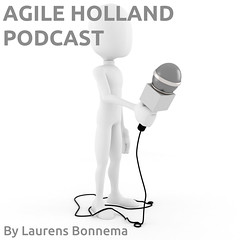 The Agile Holland Podcast is a monthly podcast with highlights from Agile Holland's meetups and conferences.
The Agile Holland Podcast is a monthly podcast with highlights from Agile Holland's meetups and conferences.
In this 1st episode, we share some impressions of our September 30th meetup/conference where we had a blast playing the GetKanban game at VX Company.
The captain of the winning team of the Getkanban game, Bianca Griffioen, is the first person to be interviewed for the Agile Holland Podcast. She's a Getkanban game vet, and likes the game for introducing Kanban to teams under the supervision of an experienced player.
Harry Nieboer uses Kanban in his work. According to Harry, the key to getting the most value out of both Kanban and the Getkanban game is smart planning. That said, luck also plays a part, as does a great team.
Jan van Beek enjoyed playing the game because of the teamwork and team decision making that are central to it. He's not sure if the game really teaches one the essentials of Kanban.
Huib Schoots likes games a lot, all kinds of games. He's not sure if the Getkanban game is really realistic. But he liked it and would recommend teams to play it to see if Kanban is something for them.
Rick IJspeerd thought the Getkanban game was really nice and educational. His key insight from the game is that limiting WIP maximizes profit. Potentially.
Want to subscribe to the Agile Holland Podcast? Subscribe via iTunes, or Stitcher.
Your feedback is appreciated. Please leave your comments in the shownotes. Better yet, send in a voice message so we can put you ON the show!
Credits
- The sounds used for podcast imaging are created by audionautix and musicradiocreative.
- All interviews were recorded in double mono with a Marantz Pro PMD661 recorder using a handheld AKG D230 dynamic mic, a Rode NTG2 condenser mic on a boompole, or a KEL HM-1 condenser mic on a mic arm resulting in a 96.0 kHz, 24-bit WAV file.
- Editing was done on a Macbook Pro using LogicPro X with iZotope RX 4 and Nectar Elements.
- Post production was done using Auphonic resulting in the final MP3 file for upload to Libsyn and distribution through iTunes and Stitcher.